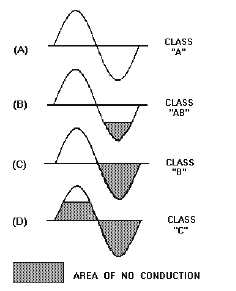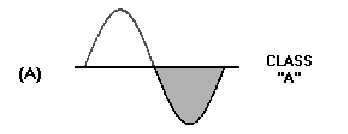2-46
There are four classes of amplifier operations: class A, class AB, class B, and class C.
CUTOFF occurs when the base-to-emitter bias prevents current from flowing in the emitter circuit.
For example, in the PNP transistor, if the base becomes positive with respect to the emitter, holes are
repelled at the emitter-base junction. This prevents current from flowing in the collector circuit.
SATURATION occurs in a PNP transistor when the base becomes so negative, with respect to the
emitter, that changes in the signal are not reflected in collector-current flow.
CLASS A AMPLIFIERS are biased so that variations in input signal polarities occur within the
limits of cutoff and saturation. Biasing an amplifier in this manner allows collector current to flow during
the complete cycle (360 degrees) of the input signal, thus providing an output which is a replica of the
input but 180 degrees out of phase.
Class A operated amplifiers are used as audio- and radio-frequency amplifiers in radio, radar, and
sound systems.
CLASS AB AMPLIFIERS are biased so that collector current is zero (cutoff) for a portion of one
alternation of the input signal. Therefore, collector current will flow for more than 180 degrees but less
than 360 degrees of the input signal. The class AB amplifier is commonly used as a push-pull amplifier to
overcome a side effect of class B operations.



